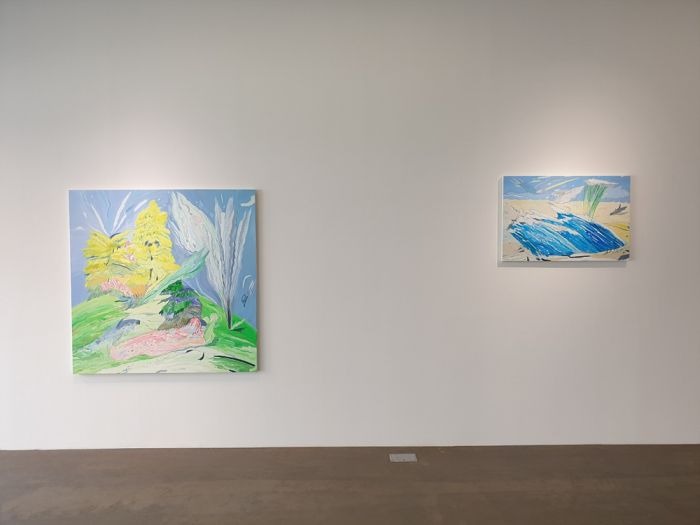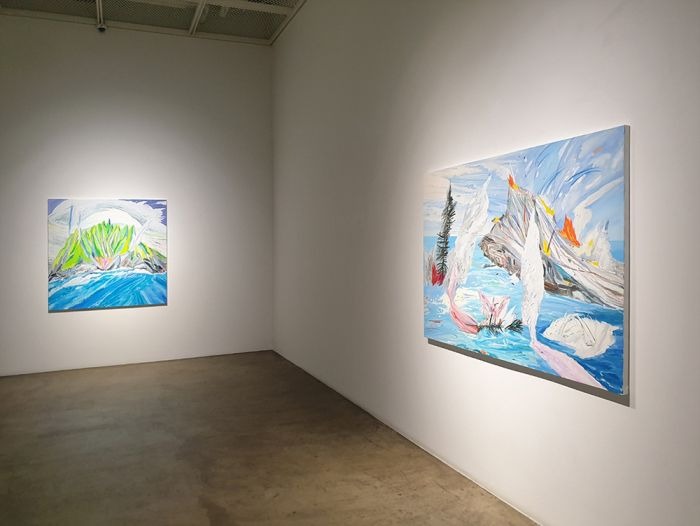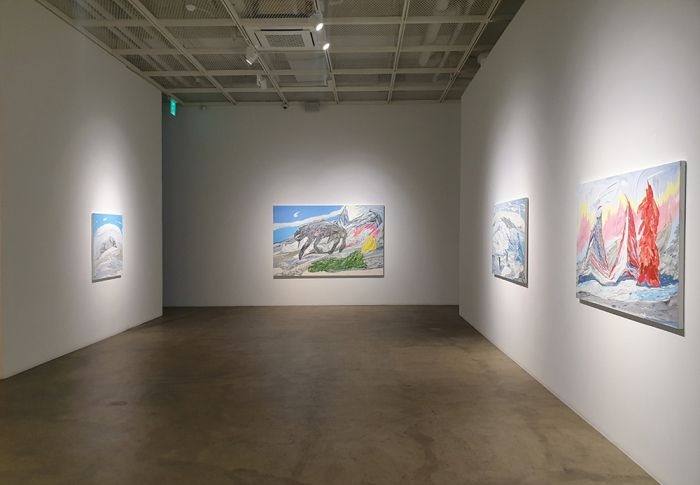
| Period| | 2020.06.04 - 2020.07.11 |
|---|---|
| Operating hours| | 10:00 - 18:00 |
| Space| | Artside Gallery |
| Address| | 15, Jahamun-ro 6-gil, Jongno-gu, Seoul, Republic of Korea |
| Closed| | Mon. Sun |
| Price| | Free |
| Phone| | 02-725-1020 |
| Web site| | 홈페이지 바로가기 |
| Artist| |
|
정보수정요청



|
|
Exhibition Information




Fake, Must Be Fake, About Feeling of Being Fake Choi, Suin’s Personal Exhibition Fake Mood Fake mood. It’s a blazing expression. It’s the feeling of which purity must not be violated. Choi Suin says with lips tight, “This feeling is fake.”1) If this is on a stage, characters have a role each. But their role doesn’t seize audiences with promised words. In the dim and distant past, far earlier than the Dionysus festival ― in the further primitive times ― the world with seeds of tragedy opened a stage. And the question, ‘Isn’t a stage narrower than the world?’ is not necessary here: the world is a stage and a stage is the world. “I” am here and “my surroundings” are here. And there are “eyes looking at me and my surroundings.”2) On the stage, I harbor hope without language, so I look for, expect, and get angry. This is the role of raw emotions. A stage presents happiness with its own body, and radiates a blooming sorrow in its place. Thus, the world is fake. A stage does not avoid reality, but confronts it, opening its eye widely. But it is fake, and anything gets better though it is fake. This is not a problem of difference or a matter of recovery. Any extent can’t intervene in it. It’s just a perfect obviousness, for which any intervention is useless. Though there is hope, it’s not scenery. The stage is full of roles, so that scenery fails to be cast for even a tiny role in it. Choi says again with lips tight, “Not scenery but imaginary picture.” How about calling the stage a role painting, instead of the term, imaginary painting, that modifies imagination with painting? Surely, Choi’s wish is not in naming.3) Naming needs deliberation, but the stage that has no niche for scenery has no place for even thinking. At first I met her like a consultant. Having read her writings about “I”, “my surroundings,” and “eyes looking at me and my surroundings,” I tried to measure how much these notions occupy in her world. I doubted for a while if her calculated intention was worked out as an output. I also assumed that her ether-like words might have been crystallized into painting. I asked her how much this mood influences her in daily life, but my question failed to reach her. It was a stupid question. As a consultant, interpreter, or translator, I had intended to help her find the share of these notions in her world by analyzing and interpreting her work. But I then realized that my attempt would give rise to a lack of understanding as I sank to the bottom of her world, disjointing it. Though Choi’s wish is conflict and tension that she creates on a fake stage, it must be admitted that they are attributes of her stage. So far, Choi has presented canvases describing a “psychodrama where main agents think of themselves as scapegoats.” In fact, a scapegoat and a main agent push away from each other in terms of their roles. It is so at a glance. But Choi knows what she should do. She understands that main agents who think of themselves as scapegoats are not scapegoats. René Girard, who wrote The Scapegoat, also stated: “Scapegoat is a kind of scapegoat.” That is, the word, scapegoat, points out both the concentration of collective violence against scapegoats and the collective result of the concentration, along with the innocence of scapegoats.4) We all live in the world where there are(were) scapegoats but they are(were) not scapegoats, needless to recall old narratives. Refined alternatives to vivid fake that sweeps in the world, too, such as imitation, forgery, and illumination, are all fake. The hope that, despite that, pushes itself to the world and the appeal of ration are hopeless next to fake. As in a psychodrama, a role can be changed by an assistant, so you can be “I,” “my surroundings,” or “eyes looking at me in the world.” Unlike in Choi’s earlier pieces, “I” do not take a certain conspicuous role in the pieces of this exhibition Fake Mood. Instead, “my surroundings” took over the position of “I.” Though as for Choi, it may be a little troublesome to hide herself, who hides in the world, on the canvas, she tried to minimize her role. She states that it is hard for her to describe objects and seize the setting at the same time. She says that she wishes to do the two things well. Making a great painting has no pretension. If you feel that there is nothing to see on her representation painting showing a scene as a whole, it might be because you don’t like discomfort. Choi only allows audiences to reach up to symbolic shapes that look like waves, trees, and clouds, and the horns and teeth drawn on the painting seem like threatening us. We are not relaxed in front of jagged mountains, waves, and trees. The sharpness on the lower part of the piece also hold a catlike aggression. The cat wouldn’t hurt you if you don’t hurt it, but it preserves a moment that will make an reaction when given a chance to stretch out its crouched body. For Choi, a moment for reaction is important. If déjà vu in a split second accords with our world, the seal of discomfort is opened, and we are allowed to enter her stage. Choi has endured hard times to reserve this moment. The thing that is not alive, a piece that looks most drastic of the pieces in this exhibition, was made after Choi saw a photo of a stuffed beast. She didn’t just copied the photo for her work. She didn’t objectify the image of the stuffed beast, but made a composition being true to the characteristic of representation. She was unpleased with ‘the end of a living thing,’ and her feeling of it was transmitted to her work. Watching this piece, we are bound to feel that any living thing can be treated like that ― it is living, but is not living, and it is dead, but is not dead. Heartrending shapes, like a goblin or a totem pole at the village entrance, recall the Latin epigram, ‘ridendo dicere severum.’5) The tree in Observer stretch up into clouds and fireworks, leaned aside. But the splendid scene drives us to anticipate the fall of the tree in a growing fear, regardless of our will. What we want is not transferring but a long suspension, so we set a pole of good luck for the work. For me, the tree in Observer looks like a pole of good luck. I ask myself, ’Is it regressive if I interpret all representation in terms of animatism?‘ Rather, I feel like discovering half of the meaning that is hidden by the world of language and the world of symbol.6) This desperation drives Choi to make an anchor that declares fake, justification that one should be fake, and potentiality that one may be fake. We live in the world that regards animatism as a regression toward infancy and urges us to grow up. So we are forced to live giving up the trends we missed in childhood, regarding them as pagans. Artists who bring these trends to the surface are ones who serve to obtain the validity of all the trends in the world.7) For the pieces of Fake Mood, Choi tried to reduce the position and power of protagonists and to ‘visualize the confusion of fake emotions that laugh at them.’ In addition, she had an more interest in color and form. She says, “At some point, I felt that it was hypocritical that I expressed hell and confusion using dark colors.” She thus made Yellow mood that looks like a fun party but gives off a feeling of anger, and An Angry Mountain where green trees of spring stretch out their branches like hooklike horns. She doesn’t think that uncomfortable and unpleasant situations are negative sides that should be hidden in her work. I talked with her about the Fanchon Red of Williamsburg that she likes, and the development of the color left a little and interesting hint. The development of the red color appears to come up from the back to the surface, which led me to think that this feeling too may be an aspect of the belief that everything has two sides, such as activeness and passiveness, action and reaction, positiveness and negativeness. For Choi, a feeling of yellow is involved with numerous feelings. She has not bias against it. A margin is not necessary to hide 1% of genuineness. She puts fake as fake. Dilution only bears a pretension. Choi wishes that there would be a time for audiences to think of something without responsibility through her pieces. It might sound irresponsible, but responsibility is a sense that follows order and ethics, so that taking responsibility is possible when accepting order and ethics. In the psychodrama where protagonists think of themselves as scapegoats, the scapegoats are atonement offerings, when mourning is a social act and a heightened emotional response to avoid the responsibility of killing the scapegoats. If we are in the world where we believe that the act to avoid responsibility that we have is true, I think it is fine to stop many things. I think we should withdraw from the world that is filled only with childlike and irresponsible things. Of whether I will choose to have language as a consultant, interpreter, and translator or to take part in playing a role harboring hope, Choi suggests me to have a time to think without responsibility. (Kim Hyunju 김현주)
